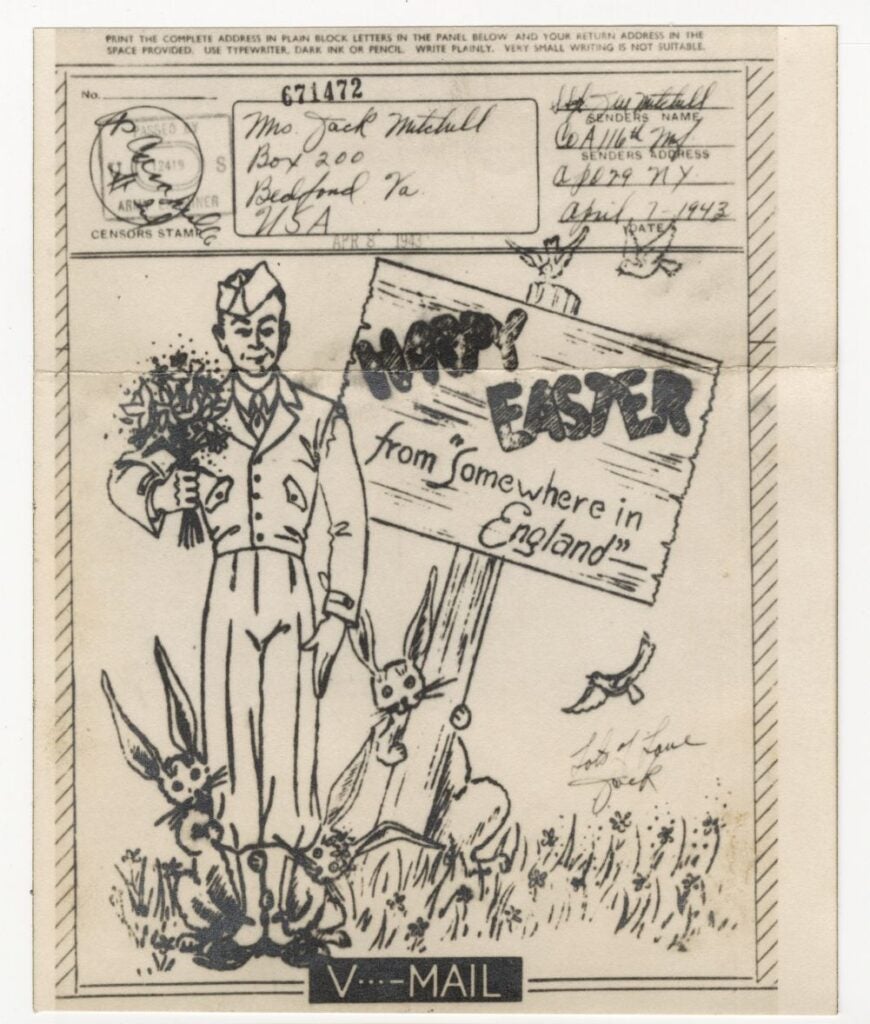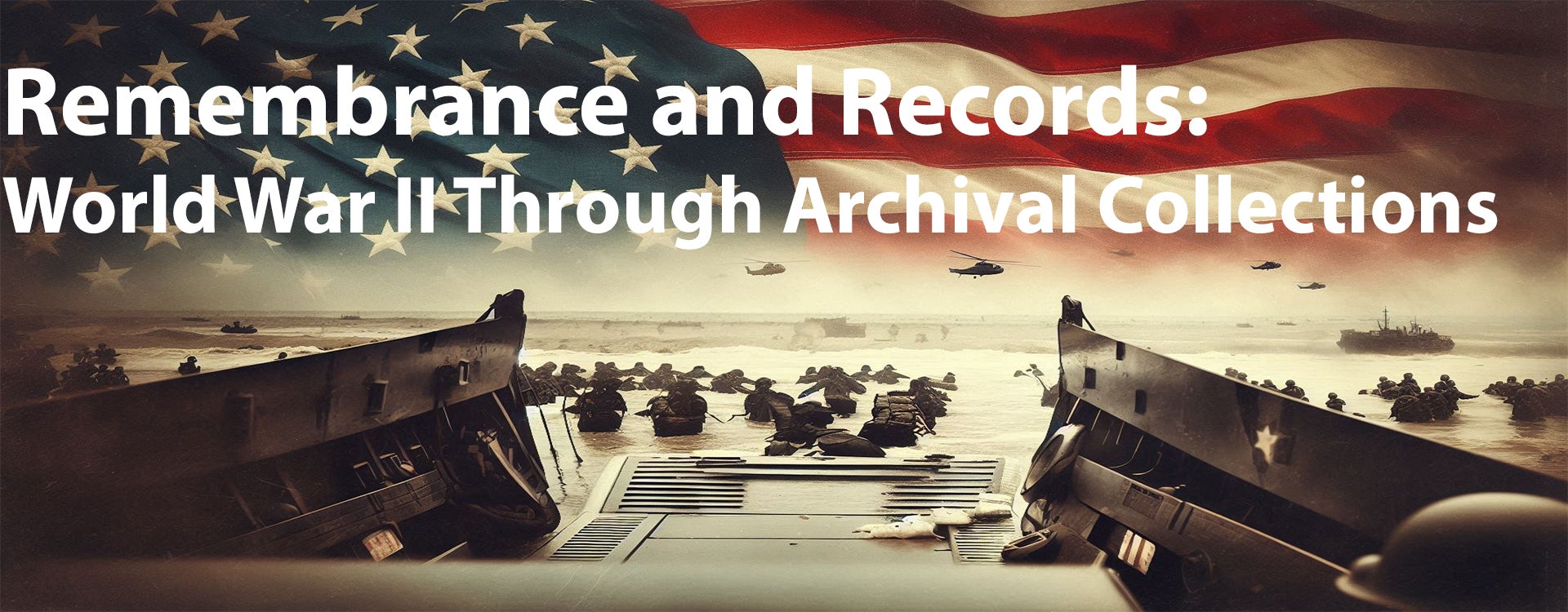Victory Mail: The Lifeline of Communication in World War II
Remembrance and Records: World War II Through Archival Collections
Over the next year, in commemoration of the 80th anniversary of the end of World War II, Joyner Library Special Collections will be highlighting items from the East Carolina Manuscripts Collection that relate to the conflict and the individuals who served.
During World War II, communication between soldiers and their families was a vital morale booster, yet logistical challenges made traditional mail delivery difficult. To address this issue, the U.S. military introduced Victory Mail, or V-Mail as it is often referred to, a secure, efficient, and space-saving method of correspondence that revolutionized wartime communication.
The Need for a New Mail System

V-mail letter dated April 28, 1944, from Walter Paas to his mother, M. A. Paas in Bronx, New York, N.Y. Item from Walter Paas Papers (#705), East Carolina Manuscript Collection, J. Y. Joyner Library, East Carolina University, Greenville, North Carolina, USA.
Before the adoption of Victory Mail, sending and receiving letters between the battlefield and the home front was a slow and cumbersome process. Traditional letters required significant cargo space, and with millions of soldiers stationed overseas, the volume of mail became overwhelming. The military faced a dilemma: how to ensure troops could stay connected with their loved ones without overburdening supply chains already stretched by the war effort.
Additionally, security was a concern. Mail could be lost, stolen, or intercepted by enemy forces. The need for a faster, more reliable, and more secure method of correspondence led to the implementation of Victory Mail in 1942.
How Victory Mail Worked
Victory Mail was based on microfilm technology, a process that drastically reduced the physical volume of mail. Here is how it worked:
- Writing the Letter—The sender would write a letter on a specially designed Victory Mail form, an 8.5 x 11-inch sheet that included space for the address, message, and return address. Due to space constraints, the letters were limited to about 700 words.
- Microfilming – Once written, the letters were sent to a processing center where they were photographed onto 16mm microfilm. A single roll of film could contain over 1,500 letters, significantly reducing the weight and volume compared to traditional mail.
- Shipment & Reproduction—The microfilm rolls were then transported to the recipient’s location, whether an overseas military post or a domestic processing center. Upon arrival, the letters were enlarged and printed onto small, 4.25 x 5-inch sheets of paper and then delivered to the recipient.
This system saved valuable cargo space, allowing military planes and ships to prioritize transporting troops, weapons, and medical supplies instead of bags of letters.
The Advantages of Victory Mail
Victory Mail offered several advantages over traditional mail:
- Efficiency & Speed – The reduction in physical bulk allowed letters to travel faster. A full sack of regular mail weighing over 50 pounds could be replaced with just a few pounds of microfilm.
- Security – Each letter was censored before filming to prevent sensitive military information from being disclosed. This reduced the risk of espionage or intercepted intelligence.
- Reliability – Victory Mail minimized the chances of letters being lost in transit, ensuring that messages reached their intended recipients.
Although Victory Mail was widely used, it did have some limitations. The strict formatting requirements and word limits frustrated some letter-writers, and the lack of handwritten personal touches made the messages feel impersonal.
Impact on Morale
Despite its limitations, Victory Mail played an essential role in maintaining morale among both soldiers and civilians. Letters from home provided comfort and motivation, reminding troops of what they were fighting for. Similarly, families on the home front found solace in receiving updates from their loved ones, even if the messages were brief.
The U.S. military and the postal service worked hard to promote the use of Victory Mail, and it became a widely accepted part of wartime life. More than a billion Victory Mail letters were sent between 1942 and 1945, demonstrating their effectiveness in keeping communication lines open during a time of global conflict.
Victory Mail Present in the East Carolina Manuscript Collection

A V-mail Easter greeting dated April 7, 1943, from Staff Sgt. Jack W. Mitchell to his wife in Bedford, Va. Item from Saunders Family Collection (#964), East Carolina Manuscript Collection, J. Y. Joyner Library, East Carolina University, Greenville, North Carolina, USA.
The East Carolina Manuscript Collection has several examples of Victory Mail found throughout several World War II related collections. These pieces of wartime correspondence include a Happy Easter card dated April 7, 1943, sent by Staff Sgt. Jack W. Mitchell to his wife in Bedford, Virginia. Staff Sgt. Mitchell was stationed in England at the time he sent this Victory Mail card. Additional examples of Victory Mail can be found in collection #189: Fairfax Kirkwood Dillon Papers and collection #705: Walter Paas Papers. Patrons interested in reading examples of this wartime correspondence between servicemembers and their loved ones can schedule an appointment to see the physical item by visiting our website at https://library.ecu.edu/specialcollections/ or view digital scans in our Digital Collections repository.
Legacy of Victory Mail
Although Victory Mail was phased out after World War II, it paved the way for advancements in secure and efficient military correspondence. The use of microfilm technology in mailing documents inspired later innovations in document storage and digital communication.
Today, historians and cultural heritage repositories treasure surviving Victory Mail letters as poignant artifacts of wartime history. These documents offer valuable insights into the thoughts and emotions of soldiers and civilians alike, preserving a personal side of World War II that might otherwise have been lost. Victory Mail remains a fascinating example of how technological ingenuity and logistical innovation can solve real-world challenges, even in the most difficult circumstances.
Visit the Ship’s Log, as well as Joyner Library’s social media channels, to learn more about materials related to World War II that are a part of the East Carolina Manuscripts Collection’s holdings. Joyner Library Special Collections will be displaying an exhibit of items and individual stories related to World War II during the summer and fall of 2025.
Sources:
- Fairfax Kirkwood Dillon Papers (#189), East Carolina Manuscript Collection, J. Y. Joyner Library, East Carolina University, Greenville, North Carolina, USA.
- Malloryk. “Mail Call: V-mail.” The National WWII Museum | New Orleans, December 6, 2019. https://www.nationalww2museum.org/war/articles/mail-call-v-mail.
- Saunders Family Collection (#964), East Carolina Manuscript Collection, J. Y. Joyner Library, East Carolina University, Greenville, North Carolina, USA.
- Walter Paas Papers (#705), East Carolina Manuscript Collection, J. Y. Joyner Library, East Carolina University, Greenville, North Carolina, USA.
